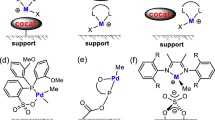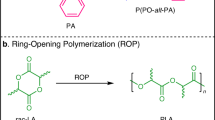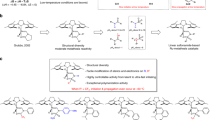Abstract
More than 50 years have passed since Ziegler and Natta shared the Nobel Prize in Chemistry for their discovery of olefin polymerization catalysts. The field of metal-catalysed polymerization has since matured, in no small part owing to the development of several high-performance catalysts. Although polymerization research has in many ways been driven by catalyst development, this has often occurred as a result of trial and error discovery of a promising motif, followed by extensive tuning of the steric and electronic properties of the ligand(s) present in the lead complex. Recently, some alternative design strategies have emerged that afforded new classes of olefin polymerization catalysts. This Perspective highlights recently designed catalyst motifs and the novel reactivity patterns they enable. Special attention is given to methods specifically designed for the copolymerization of ethylene with polar-functionalized co-monomers — challenging reactions that showcase these creatively designed catalyst motifs.
This is a preview of subscription content, access via your institution
Access options
Access Nature and 54 other Nature Portfolio journals
Get Nature+, our best-value online-access subscription
$29.99 / 30 days
cancel any time
Subscribe to this journal
Receive 12 digital issues and online access to articles
$119.00 per year
only $9.92 per issue
Buy this article
- Purchase on Springer Link
- Instant access to full article PDF
Prices may be subject to local taxes which are calculated during checkout





Similar content being viewed by others
References
AlMaadeed, M. A.-A. & Krupa, I. Polyolefin Compounds and Materials (Springer, Heidelberg, 2016).
Severn, J. R. & Chadwick, J. C. Tailor-Made Polymers (Wiley VCH, Weinheim, 2008).
Sauter, D. W., Taoufik, M. & Boisson, C. Polyolefins, a success story. Polymers 9, 185 (2017).
Sailors, H. R. & Hogan, J. P. History of polyolefins. J. Macromol. Sci. Part A Chem. 15, 1377–1402 (1981).
Alt, H. G. & Köppl, A. Effect of the nature of metallocene complexes of group IV metals on their performance in catalytic ethylene and propylene polymerization. Chem. Rev. 100, 1205–1221 (2000).
Coates, W. C. Precise control of polyolefin stereochemistry using single-site metal catalysts. Chem. Rev. 100, 1223–1252 (2000).
Braunschweig, H. & Breitling, F. M. Constrained geometry complexes — synthesis and applications. Coord. Chem. Rev. 250, 2691–2720 (2006).
Domski, G. J., Rose, J. M., Coates, G. W., Bolig, A. D. & Brookhart, M. Living alkene polymerization: new methods for the precision synthesis of polyolefins. Prog. Polym. Sci. 32, 30–92 (2007).
Guan, Z. B. & Popeney, C. S. Recent progress in late transition metal α-diimine catalysts for olefin polymerization. Top. Organomet. Chem. 26, 179–220 (2009).
Flisak, Z. & Sun, W.-H. Progression of diiminopyridines: from single application to catalytic versatility. ACS Catal. 5, 4713–4724 (2015).
Makio, H., Terao, H., Iwashita, A. & Fujita, T. FI catalysts for olefin polymerization — a comprehensive treatment. Chem. Rev. 111, 2363–2449 (2011).
Collins, R. A., Russell, A. F. & Mountford, P. Group 4 metal complexes for homogeneous olefin polymerisation: a short tutorial review. Appl. Petrochem. Res. 5, 153–171 (2015).
Gibson, V. C. & Solan, G. A. Iron-based and cobalt-based olefin polymerisation catalysts. Top. Organomet. Chem. 26, 107–158 (2009).
Mu, H., Pan, L., Song, D. & Li, Y. Neutral nickel catalysts for olefin homo- and copolymerization: relationships between catalyst structures and catalytic properties. Chem. Rev. 115, 12091–12137 (2015).
Wei, Y., Wang, S. & Zhou, S. Aluminum alkyl complexes: synthesis, structure, and application in ROP of cyclic esters. Dalton Trans. 45, 4471–4485 (2016).
Pintauer, T. & Matyjaszewski, K. Structural and mechanistic aspects of copper catalyzed atom transfer radical polymerization. Top. Organomet. Chem. 26, 221–251 (2009).
Kim, J. & Hong, S. H. Ligand-promoted direct C–H arylation of simple arenes: evidence for a cooperative bimetallic mechanism. ACS Catal. 7, 3336–3343 (2017).
Obligacion, J. V. & Chirik, P. J. Earth-abundant transition metal catalysts for alkene hydrosilylation and hydroboration. Nat. Rev. Chem. 2, 0149 (2018).
Tondreau, A. M. et al. Iron catalysts for selective anti-Markovnikov alkene hydrosilylation using tertiary silanes. Science 335, 567–570 (2012).
Paul, J. C. Carbon–carbon bond formation in a weak ligand field: leveraging open-shell first-row transition-metal catalysts. Angew. Chem. Int. Ed. 56, 5170–5181 (2017).
Hoyt, J. M., Schmidt, V. A., Tondreau, A. M. & Chirik, P. J. Iron-catalyzed intermolecular [2 + 2] cycloadditions of unactivated alkenes. Science 349, 960–963 (2015).
Busico, V. Ziegler–Natta catalysis: forever young. MRS Bull. 38, 224–228 (2013).
Spaleck, W. et al. The influence of aromatic substituents on the polymerization behavior of bridged zirconocene catalysts. Organometallics 13, 954–963 (1994).
Boffa, L. S. & Novak, B. M. Copolymerization of polar monomers with olefins using transition-metal complexes. Chem. Rev. 100, 1479–1494 (2000).
Franssen, N. M. G., Reek, J. N. H. & de Bruin, B. Synthesis of functional ‘polyolefins’: state of the art and remaining challenges. Chem. Soc. Rev. 42, 5809–5832 (2013).
Nakamura, A., Ito, S. & Nozaki, K. Coordination–insertion copolymerization of fundamental polar monomers. Chem. Rev. 109, 5215–5244 (2009).
Chen, E. Y.-X. Coordination polymerization of polar vinyl monomers by single-site metal catalysts. Chem. Rev. 109, 5157–5214 (2009).
Gladysz, J. A. et al. Organometallics roundtable 2011. Organometallics 31, 1–18 (2012).
Arriola, D. J., Carnahan, E. M., Hustad, P. D., Kuhlman, R. L. & Wenzel, T. T. Catalytic production of olefin block copolymers via chain shuttling polymerization. Science 312, 714–719 (2006).
Hustad, P. D. Frontiers in olefin polymerization: reinventing the world’s most common synthetic polymers. Science 325, 704–707 (2009).
Pan, L., Zhang, K., Nishiura, M. & Hou, Z. Chain-shuttling polymerization at two different scandium sites: regio- and stereospecific “one-pot” block copolymerization of styrene, isoprene, and butadiene. Angew. Chem. Int. Ed. 50, 12012–12015 (2011).
Chen, E. Y.-X. & Marks, T. J. Cocatalysts for metal-catalyzed olefin polymerization: activators, activation processes, and structure–activity relationships. Chem. Rev. 100, 1391–1434 (2000).
Younkin, T. R. et al. Neutral, single-component nickel(ii) polyolefin catalysts that tolerate heteroatoms. Science 287, 460–462 (2000).
Xi, Z., Bazzi, H. S. & Gladysz, J. A. Activation of single-component nickel(ii) polyethylene catalysts via phase transfer of fluorous phosphine ligands. J. Am. Chem. Soc. 137, 10930–10933 (2015).
da Costa, R. C. & Gladysz, J. A. Fluorous phase transfer activation of catalysts: application of a new rate-enhancement strategy to alkene metathesis. Chem. Commun. 42, 2619–2621 (2006).
Delferro, M. & Marks, T. J. Multinuclear olefin polymerization catalysts. Chem. Rev. 111, 2450–2485 (2011).
Takeuchi, D., Chiba, Y., Takano, S. & Osakada, K. Double-decker-type dinuclear nickel catalyst for olefin polymerization: efficient incorporation of functional co-monomers. Angew. Chem. Int. Ed. 52, 12536–12540 (2013).
Takano, S., Takeuchi, D., Osakada, K., Akamatsu, N. & Shishido, A. Dipalladium catalyst for olefin polymerization: introduction of acrylate units into the main chain of branched polyethylene. Angew. Chem. Int. Ed. 53, 9246–9250 (2014).
Radlauer, M. R., Buckley, A. K., Henling, L. M. & Agapie, T. Bimetallic coordination insertion polymerization of unprotected polar monomers: copolymerization of amino olefins and ethylene by dinickel bisphenoxyiminato catalysts. J. Am. Chem. Soc. 135, 3784–3787 (2013).
Johnson, L. K., Killian, C. M. & Brookhart, M. New Pd(ii)- and Ni(ii)-based catalysts for polymerization of ethylene and α-olefins. J. Am. Chem. Soc. 117, 6414–6415 (1995).
Johnson, L. K., Mecking, S. & Brookhart, M. Copolymerization of ethylene and propylene with functionalized vinyl monomers by palladium(ii) catalysts. J. Am. Chem. Soc. 118, 267–268 (1996).
Juliá-Hernández, F., Moragas, T., Cornella, J. & Martin, R. Remote carboxylation of halogenated aliphatic hydrocarbons with carbon dioxide. Nature 545, 84–88 (2017).
Vasseur, A., Bruffaerts, J. & Marek, I. Remote functionalization through alkene isomerization. Nat. Chem. 8, 209–219 (2016).
Camacho, D. H. & Guan, Z. Designing late-transition metal catalysts for olefin insertion polymerization and copolymerization. Chem. Commun. 46, 7879–7893 (2010).
Dong, Z. & Ye, Z. Hyperbranched polyethylenes by chain walking polymerization: synthesis, properties, functionalization, and applications. Polym. Chem. 3, 286–301 (2012).
Guo, L. & Chen, C. (α-Diimine)palladium catalyzed ethylene polymerization and (co)polymerization with polar comonomers. Sci. China Chem. 58, 1663–1673 (2015).
Chen, Z., Liu, W., Daugulis, O. & Brookhart, M. Mechanistic studies of Pd(ii)-catalyzed copolymerization of ethylene and vinylalkoxysilanes: evidence for a β-silyl elimination chain transfer mechanism. J. Am. Chem. Soc. 138, 16120–16129 (2016).
Guo, L., Dai, S., Sui, X. & Chen, C. Palladium and nickel catalyzed chain walking olefin polymerization and copolymerization. ACS Catal. 6, 428–441 (2016).
Guo, L., Liu, W. & Chen, C. Late transition metal catalyzed α-olefin polymerization and copolymerization with polar monomers. Mater. Chem. Front. 1, 2487–2494 (2017).
Nakamura, A. et al. Ortho-phosphinobenzenesulfonate: a superb ligand for palladium-catalyzed coordination–insertion copolymerization of polar vinyl monomers. Acc. Chem. Res. 46, 1438–1449 (2013).
Williams, B. S., Leatherman, M. D., White, P. S. & Brookhart, M. Reactions of vinyl acetate and vinyl trifluoroacetate with cationic diimine Pd(ii) and Ni(ii) alkyl complexes: identification of problems connected with copolymerizations of these monomers with ethylene. J. Am. Chem. Soc. 127, 5132–5146 (2005).
Chen, C. & Jordan, R. F. Palladium-catalyzed dimerization of vinyl ethers to acetals. J. Am. Chem. Soc. 132, 10254–10255 (2010).
Chen, C., Luo, S. & Jordan, R. F. Cationic polymerization and insertion chemistry in the reactions of vinyl ethers with (α-diimine)PdMe+ species. J. Am. Chem. Soc. 132, 5273–5284 (2010).
Chen, C., Luo, S. & Jordan, R. F. Multiple insertion of a silyl vinyl ether by (α-diimine)PdMe+ species. J. Am. Chem. Soc. 130, 12892–12893 (2008).
Kang, M., Sen, A., Zakharov, L. & Rheingold, A. L. Diametrically opposite trends in alkene insertion in late and early transition metal compounds: relevance to transition-metal-catalyzed polymerization of polar vinyl monomers. J. Am. Chem. Soc. 124, 12080–12081 (2002).
Foley, S. R., Stockland, R. A., Shen, H. & Jordan, R. F. Reaction of vinyl chloride with late transition metal olefin polymerization catalysts. J. Am. Chem. Soc. 125, 4350–4361 (2003).
Li, S. & Ye, Z. Synthesis of narrowly distributed ω-telechelic hyperbranched polyethylenes by efficient end-capping of Pd-diimine-catalyzed ethylene “living” polymerization with styrene derivatives. Macromol. Chem. Phys. 211, 1917–1924 (2010).
Dai, S., Sui, X. & Chen, C. Highly robust palladium(ii) α-diimine catalysts for slow-chain-walking polymerization of ethylene and copolymerization with methyl acrylate. Angew. Chem. Int. Ed. 54, 9948–9953 (2015).
Dai, S. & Chen, C. Direct synthesis of functionalized high-molecular-weight polyethylene by copolymerization of ethylene with polar monomers. Angew. Chem. Int. Ed. 55, 13281–13285 (2016).
Dai, S., Zhou, S., Zhang, W. & Chen, C. Systematic investigations of ligand steric effects on α-diimine palladium catalyzed olefin polymerization and copolymerization. Macromolecules 49, 8855–8862 (2016).
Iwashita, A., Chan, M. C. W., Makio, H. & Fujita, T. Attractive interactions in olefin polymerization mediated by post-metallocene catalysts with fluorine-containing ancillary ligands. Catal. Sci. Technol. 4, 599–610 (2014).
Weberski, M. P. et al. Suppression of β-hydride chain transfer in nickel(ii)-catalyzed ethylene polymerization via weak fluorocarbon ligand–product interactions. Organometallics 31, 3773–3789 (2012).
Stephenson, C. J. et al. Ni(ii) phenoxyiminato olefin polymerization catalysis: striking coordinative modulation of hyperbranched polymer microstructure and stability by a proximate sulfonyl group. ACS Catal. 4, 999–1003 (2014).
Popeney, C. S., Rheingold, A. L. & Guan, Z. Nickel(ii) and palladium(ii) polymerization catalysts bearing a fluorinated cyclophane ligand: stabilization of the reactive intermediate. Organometallics 28, 4452–4463 (2009).
Bryliakov, K. P., Talsi, E. P., Möller, H. M., Baier, M. C. & Mecking, S. Noncovalent interactions in o-fluorinated post-titanocene living ethylene polymerization catalyst. Organometallics 29, 4428–4430 (2010).
Li, M., Wang, X., Luo, Y. & Chen, C. A second-coordination-sphere strategy to modulate nickel- and palladium-catalyzed olefin polymerization and copolymerization. Angew. Chem. Int. Ed. 56, 11604–11609 (2017).
Zhang, D. & Chen, C. Influence of polyethylene glycol unit on palladium- and nickel-catalyzed ethylene polymerization and copolymerization. Angew. Chem. Int. Ed. 56, 14672–14676 (2017).
Liu, D. et al. Highly isoselective coordination polymerization of ortho-methoxystyrene with β-diketiminato rare-earth-metal precursors. Angew. Chem. Int. Ed. 54, 5205–5209 (2015).
Liu, D. et al. Stereoselective copolymerization of unprotected polar and nonpolar styrenes by an yttrium precursor: control of polar-group distribution and mechanism. Angew. Chem. Int. Ed. 56, 2714–2719 (2017).
Leicht, H., Göttker-Schnetmann, I. & Mecking, S. Synergetic effect of monomer functional group coordination in catalytic insertion polymerization. J. Am. Chem. Soc. 139, 6823–6826 (2017).
Wang, C. et al. Heteroatom-assisted olefin polymerization by rare-earth metal catalysts. Sci. Adv. 3, e1701011 (2017).
Leibfarth, F. A., Mattson, K. M., Fors, B. P., Collins, H. A. & Hawker, C. J. External regulation of controlled polymerizations. Angew. Chem. Int. Ed. 52, 199–210 (2013).
Teator, A. J., Lastovickova, D. N. & Bielawski, C. W. Switchable polymerization catalysts. Chem. Rev. 116, 1969–1992 (2016).
Yoon, H. J., Kuwabara, J., Kim, J.-H. & Mirkin, C. A. Allosteric supramolecular triple-layer catalysts. Science 330, 66–69 (2010).
Magenau, A. J. D., Strandwitz, N. C., Gennaro, A. & Matyjaszewski, K. Electrochemically mediated atom transfer radical polymerization. Science 332, 81–84 (2011).
Theriot, J. C. et al. Organocatalyzed atom transfer radical polymerization driven by visible light. Science 352, 1082–1086 (2016).
Gregson, C. K. A. et al. Redox control within single-site polymerization catalysts. J. Am. Chem. Soc. 128, 7410–7411 (2006).
Wang, X. et al. Redox control of group 4 metal ring-opening polymerization activity toward l-lactide and ε-caprolactone. J. Am. Chem. Soc. 136, 11264–11267 (2014).
Biernesser, A. B., Chiaie, K. R. D., Curley, J. B. & Byers, J. A. Block copolymerization of lactide and an epoxide facilitated by a redox switchable iron-based catalyst. Angew. Chem. Int. Ed. 55, 5251–5254 (2016).
Savka, R., Foro, S., Gallei, M., Rehahn, M. & Plenio, H. Oxidation-triggered ring-opening metathesis polymerization. Chem. Eur. J. 19, 10655–10662 (2013).
Varnado Jr., C. D., Rosen, E. L., Collins, M. S., Lynch, V. M. & Bielawski, C. W. Synthesis and study of olefin metathesis catalysts supported by redox-switchable diaminocarbene[3]ferrocenophanes. Dalton Trans. 42, 13251–13264 (2013).
Teator, A. J. & Bielawski, C. W. Remote control grubbs catalysts that modulate ring-opening metathesis polymerizations. J. Poly. Sci. A Poly. Chem. 55, 2949–2960 (2017).
Gibson, V. C., Long, N. J., Oxford, P. J., White, A. J. P. & Williams, D. J. Ferrocene-substituted bis-(imino)pyridine iron and cobalt complexes: toward redox-active catalysts for the polymerization of ethylene. Organometallics 25, 1932–1939 (2006).
Chen, M., Yang, B. & Chen, C. Redox-controlled olefin (co)polymerization catalyzed by ferrocene bridged phosphine-sulfonate palladium complexes. Angew. Chem. Int. Ed. 54, 15520–15524 (2015).
Zhao, M. & Chen, C. Accessing multiple catalytically active states in redox controlled olefin polymerization. ACS Catal. 7, 7490–7494 (2017).
Anderson Jr., W. C., Rhinehart, J. L., Tennyson, A. G. & Long, B. K. Redox-active ligands: an advanced tool to modulate polyethylene microstructure. J. Am. Chem. Soc. 138, 774–777 (2016).
Acknowledgements
This work was supported by the National Natural Science Foundation of China (NSFC, 51522306 and 21690071).
Author information
Authors and Affiliations
Corresponding author
Ethics declarations
Competing interests
The author declares no competing interests.
Additional information
Publisher’s note
Springer Nature remains neutral with regard to jurisdictional claims in published maps and institutional affiliations.
Rights and permissions
About this article
Cite this article
Chen, C. Designing catalysts for olefin polymerization and copolymerization: beyond electronic and steric tuning. Nat Rev Chem 2, 6–14 (2018). https://doi.org/10.1038/s41570-018-0003-0
Published:
Issue Date:
DOI: https://doi.org/10.1038/s41570-018-0003-0
This article is cited by
-
A co-anchoring strategy for the synthesis of polar bimodal polyethylene
Nature Communications (2023)
-
Nickel-catalysed hydrodimerization of unactivated terminal alkenes
Nature Synthesis (2023)
-
Phenyl-bridged bis-salicylaldiminato binuclear titanium complexes for ethylene (co)polymerization
Journal of Polymer Research (2023)
-
A “Catalyst+Support” Strategy for Salicylaldimine Nickel Catalyzed Ethylene Polymerization and Copolymerization with Polar Monomers
Chemical Research in Chinese Universities (2023)
-
Controllable Preparation of Branched Polyolefins with Various Microstructural Units via Chain-walking Ethylene and Pentene Polymerizations
Chinese Journal of Polymer Science (2023)



